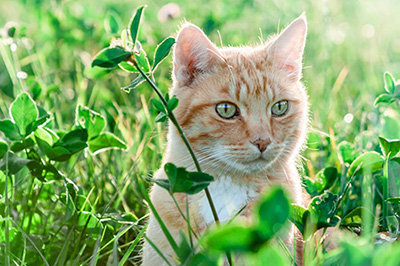Toxic Plants to Avoid at Home
 Dogs and cats often nibble on plants in the house or yard, but not all plants are safe to be eaten. As you are shopping for plants this spring, keep in mind that many common options are very toxic, and even deadly, to pets.
Dogs and cats often nibble on plants in the house or yard, but not all plants are safe to be eaten. As you are shopping for plants this spring, keep in mind that many common options are very toxic, and even deadly, to pets.
Murl Bailey, a professor at the Texas A&M College of Veterinary Medicine & Biomedical Sciences, has advice for pet owners who are not sure which plants to avoid.
Common indoor plants that are toxic to cats include the Easter Lily, Tiger Lily, Day Lily, and Dieffenbachia, commonly called Spotted Dumbcane. Bailey said that if a cat eats a lily, treatment needs to begin within 24 hours to avoid serious kidney damage.
Dieffenbachia is also toxic to dogs, as well as Kalanchoe, a small flowering succulent that can cause vomiting, heart problems, and convulsions.
Bailey said that there are several plants commonly used for outdoor landscaping that are also very toxic to pets.
- All parts of sago palms, also called cycads, are very poisonous, but the seeds contain the most toxins.
- Oleander, a pink flowering shrub, has toxins that harm cellular metabolism and can cause GI tract issues or heart problems. Bailey said this plant is very dangerous for horses, as well as dogs and cats.
- Brunfelsia, a plant with purple flowers also known as Yesterday, Today and Tomorrow, is also poisonous, especially to dogs and cattle. It grows wild in Florida but is commonly found in gardens all over the Southern US.
- Tulips, azaleas, rhododendron, lilies, yews, and castor bean plants should also be avoided.
The best option for pet owners is to keep these plants out of the yard, or at least in an area that pets cannot access.
Bailey also recommends looking at the ASPCA website’s poisonous plants page for information on other plants that may or may not be toxic. The website can be found at https://www.aspca.org/pet-care/animal-poison-control/toxic-and-non-toxic-plants.
If a pet does eat a toxic plant, owners may begin seeing symptoms right away, or they may develop over time.
“Initially, when pets ingest toxic plants, the first symptom is vomiting,” Bailey said. “Depending upon which plant is ingested, the animal may develop loose bowels, become depressed, or show excitement.”
Pets who have eaten toxic plants should be taken to an animal emergency clinic as soon as possible. Pet owners can also call the ASPCA poison control line at 888-426-4435.
Dogs and cats often try to eat plants due to boredom or curiosity, but they do not need them for nutrition. Bailey suggests training pets to leave plants alone or providing toys as a distraction. The best solution is to keep all plants out of a pet’s reach.
Plants may be beautiful and great for landscaping, but they are not worth the loss of a pet’s life. Smart plant choices are the best way to make sure your pet is not at risk for any plant poisoning.
Pet Talk is a service of the Texas A&M College of Veterinary Medicine & Biomedical Sciences. Stories can be viewed on the web at vetmed.tamu.edu/pet-talk. Suggestions for future topics may be directed to editor@cvm.tamu.edu.


